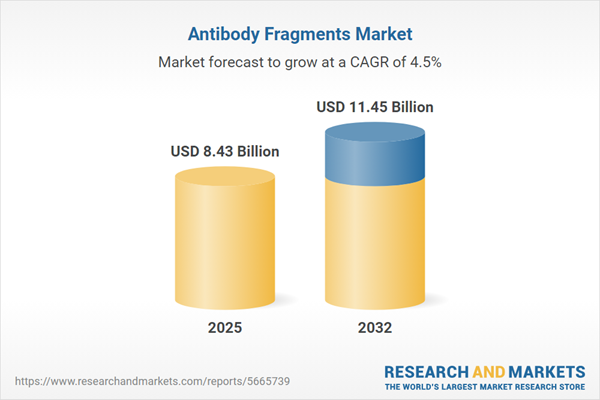Speak directly to the analyst to clarify any post sales queries you may have.
Senior decision-makers in biopharmaceuticals and diagnostics are increasingly adopting modular and high-precision approaches to address evolving therapeutic and diagnostic challenges. The antibody fragments market is advancing through innovative R&D, robust collaborations, and shifting supply chain strategies, shaping a dynamic landscape for targeted biologics solutions.
Antibody Fragments Market Snapshot
The antibody fragments market grew from USD 8.07 billion in 2024 to USD 8.43 billion in 2025. It is expected to continue growing at a CAGR of 4.46%, reaching USD 11.45 billion by 2032. This upward trend highlights the adoption of fragments in precision-targeted therapies, diagnostics, and advanced research. Growth is supported by advancements in protein engineering, increased investment in next-generation biologics, and a strategic pivot toward modular treatment formats.
Scope & Segmentation of the Antibody Fragments Market
This comprehensive market intelligence report segments the antibody fragments industry, helping leaders identify emerging opportunities:
- Product Types: Diabodies (Camelid, Shark), Fab Fragments (Chimeric, Fully Human, Humanized, Murine), Fab'2 Fragments (Chimeric, Fully Human, Humanized, Murine), Nanobodies (Camelid, Shark), Single Chain Variable Fragments (Chimeric, Fully Human, Humanized, Murine)
- Applications: Diagnostics (Imaging, In Vitro Diagnostics, Point Of Care Testing), Drug Delivery (Gene Delivery, Targeted Drug Delivery), Research (Basic Research, Drug Discovery, Preclinical Research), Therapeutics (Infectious Diseases, Inflammatory Diseases, Oncology)
- End Users: Academic and Research Institutes, Contract Research Organizations, Diagnostic Laboratories, Pharmaceutical and Biotechnology Companies
- Technologies: Hybridoma, Molecular Cloning, Phage Display (Filamentous Phage, Lambda Phage, T7 Phage), Recombinant Technology (Bacterial Expression, Mammalian Expression, Yeast Expression)
- Distribution Channels: Direct Sales, Distributors, Online Sales (Company Website, Third Party E-Commerce)
- Geographical Regions: Americas (United States, Canada, Mexico, Brazil, Argentina, Chile, Colombia, Peru), Europe, Middle East & Africa (United Kingdom, Germany, France, Russia, Italy, Spain, Netherlands, Sweden, Poland, Switzerland, United Arab Emirates, Saudi Arabia, Qatar, Turkey, Israel, South Africa, Nigeria, Egypt, Kenya), Asia-Pacific (China, India, Japan, Australia, South Korea, Indonesia, Thailand, Malaysia, Singapore, Taiwan)
- Major Companies Profiled: Thermo Fisher Scientific Inc., Danaher Corporation, Merck KGaA, Bio-Rad Laboratories Inc., PerkinElmer Inc., QIAGEN N.V., Abcam plc, GenScript Biotech Corporation, Sanofi S.A., MorphoSys AG
Key Takeaways for Antibody Fragments Market Stakeholders
- Antibody fragments deliver precise targeting with reduced immunogenic risk, driving adoption in both diagnostics and therapy pipelines.
- Emergent protein engineering and phage display technologies are enabling rapid generation of tailored fragment libraries with expanded binding profiles.
- The diversification of product segments, including nanobody and diabody formats, meets the need for compact, stable molecules in imaging, drug delivery, and point-of-care uses.
- End-user interests span from pharmaceutical companies focused on new therapies to academics leveraging fragments for preclinical validation and drug discovery.
- Regional differences impact regulatory timelines, investment priorities, and manufacturing approaches, requiring tailored go-to-market strategies for global expansion.
Impact of United States Tariffs on the Antibody Fragments Market
The 2025 introduction of new U.S. tariffs has affected global supply chains for antibody fragments. Increased import duties on reagents and materials have elevated production costs, prompting companies to strengthen local manufacturing and realign supplier partnerships. This disruption has triggered a heightened focus on agile sourcing and risk mitigation, as well as accelerating investments in nearshoring and streamlined customs processes to maintain program continuity.
Methodology & Data Sources
The insights in this report were validated through a combination of rigorous secondary research and targeted primary interviews with senior executives and R&D leaders. Included sources span scientific literature, regulatory filings, and proprietary transaction databases, ensuring robust triangulation and comprehensive accuracy. Regional specialists contributed insight on localized market forces, regulatory nuances, and competitive dynamics.
Why This Report Matters
- Provides actionable intelligence on product, application, and technology trends, supporting strategic investment decisions for antibody fragment solutions.
- Informs leaders of supply chain vulnerabilities and partnership models to safeguard innovation amid shifting trade and regulatory landscapes.
- Enables market entry and growth by clarifying segmentation, regional influences, and the evolving competitive environment.
Conclusion
As scientific advances and structural shifts converge within the antibody fragments sector, stakeholders equipped with deep market intelligence will be best positioned to drive growth and resilience. This report empowers leaders pursuing leadership in a complex, innovation-driven landscape.
Additional Product Information:
- Purchase of this report includes 1 year online access with quarterly updates.
- This report can be updated on request. Please contact our Customer Experience team using the Ask a Question widget on our website.
Table of Contents
3. Executive Summary
4. Market Overview
7. Cumulative Impact of Artificial Intelligence 2025
Companies Mentioned
The companies profiled in this Antibody Fragments market report include:- Thermo Fisher Scientific Inc.
- Danaher Corporation
- Merck KGaA
- Bio-Rad Laboratories, Inc.
- PerkinElmer, Inc.
- QIAGEN N.V.
- Abcam plc
- GenScript Biotech Corporation
- Sanofi S.A.
- MorphoSys AG
Table Information
| Report Attribute | Details |
|---|---|
| No. of Pages | 187 |
| Published | October 2025 |
| Forecast Period | 2025 - 2032 |
| Estimated Market Value ( USD | $ 8.43 Billion |
| Forecasted Market Value ( USD | $ 11.45 Billion |
| Compound Annual Growth Rate | 4.4% |
| Regions Covered | Global |
| No. of Companies Mentioned | 11 |









